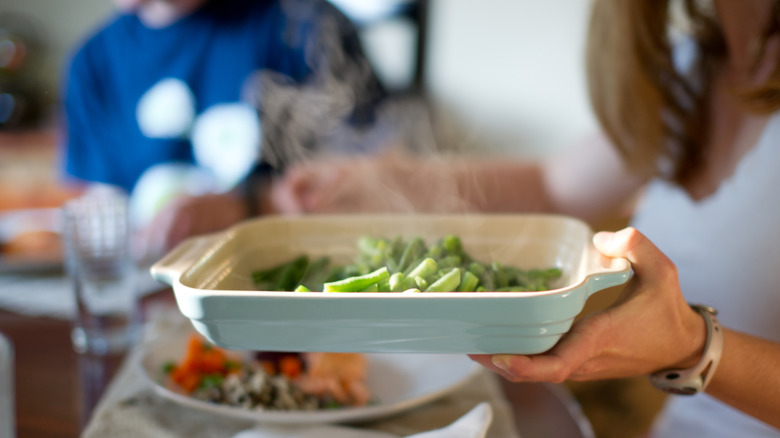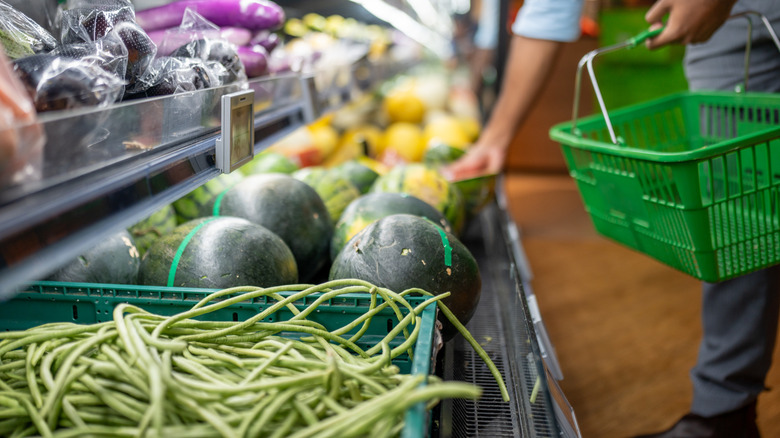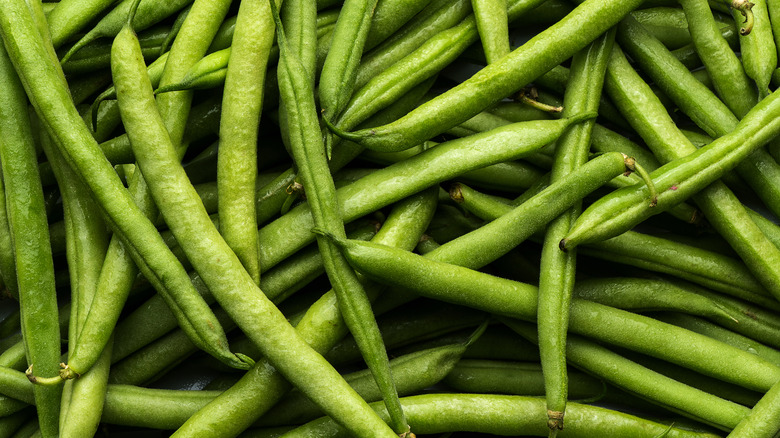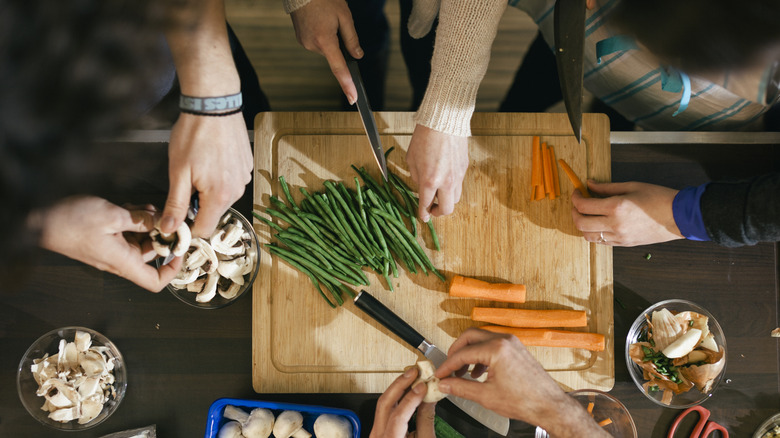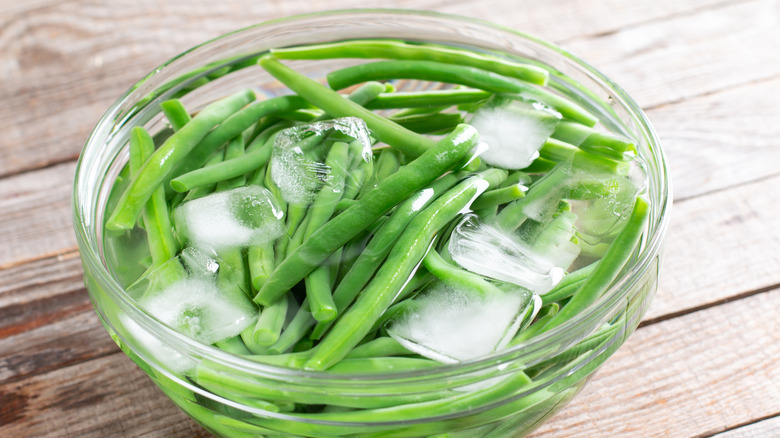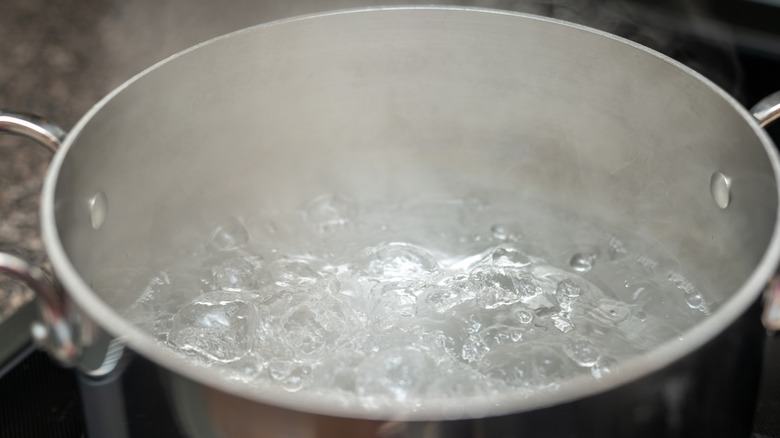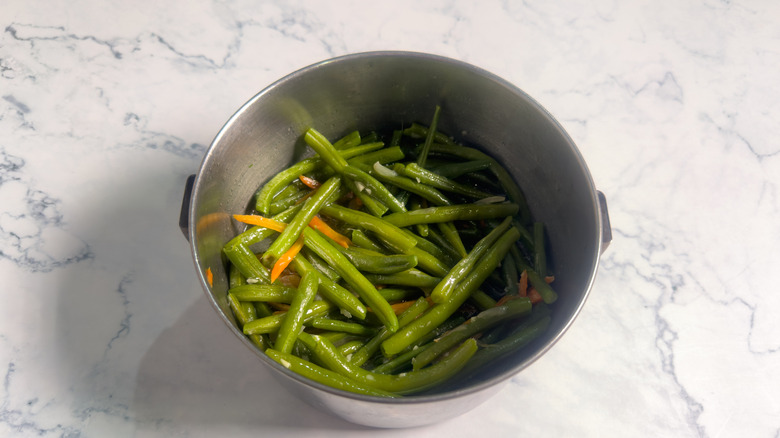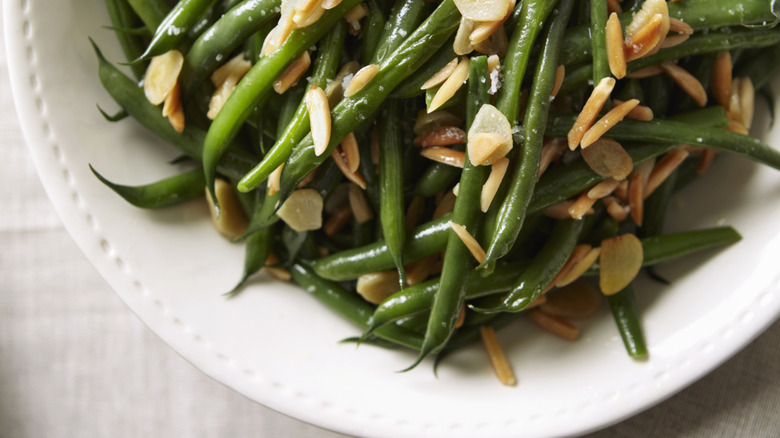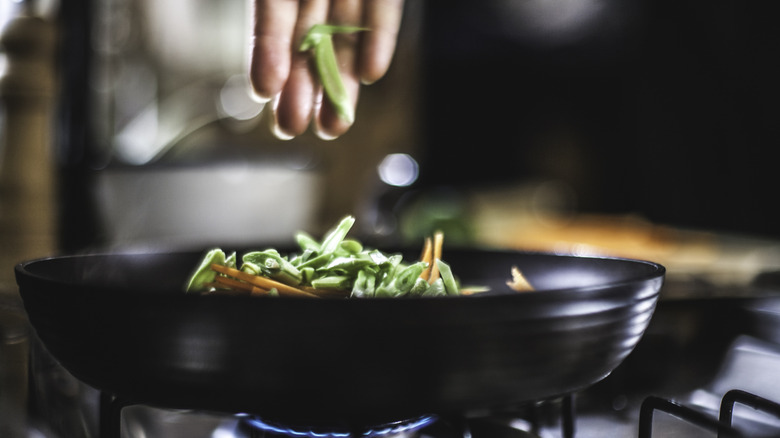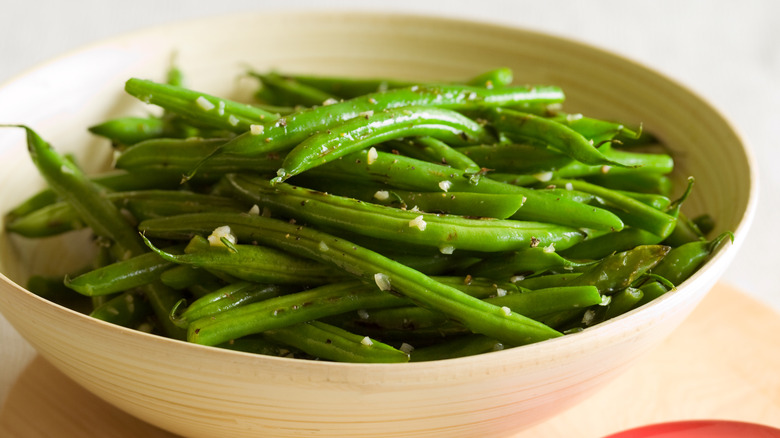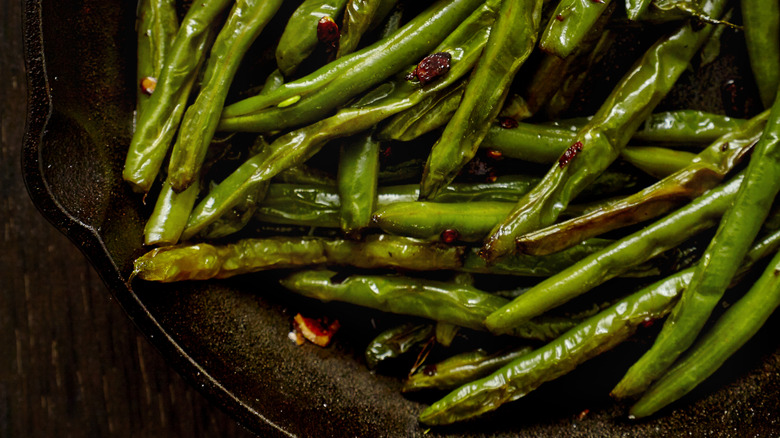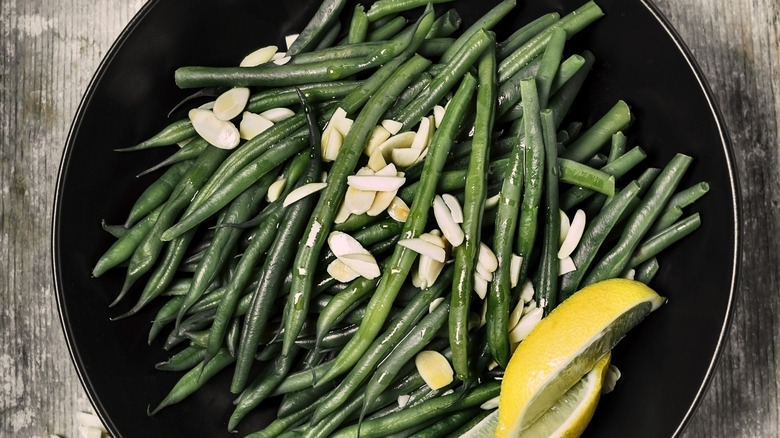Why Green Beans Always Taste Better At A Restaurant, According To Chefs
Green beans have a place on the table whether it be at home during the holidays with a turkey or at your favorite restaurant accompanying a steak as a stellar side dish. But green beans can go beyond the Thanksgiving casserole we know and love. These bush bean vegetables are different from their bean counterparts like black beans because they are cooked in their pods. They can also be interchangeably called string beans, snap beans, or haricots verts in French.
While it may seem simple to cook green beans, there is a certain technique behind making them perfectly crisp yet tender and complementary to the bean's natural flavor. While you may struggle to model the green beans you taste at restaurants where they seem to be cooked to perfection, it is totally doable to perfect your green beans at home. Chefs have weighed in on why green beans always seem to taste better at a restaurant, the secrets to getting a perfectly cooked texture, and what you should avoid doing when preparing at home.
Finding the right green bean fit
The first reason your green beans may not taste like those at a restaurant is your choice of produce. Not only is there more than one type of green bean, but also green beans aren't all the same. "There are several varieties of green beans, and the best choice depends on your recipe. For example, haricots verts are a finer, longer variety that should only be boiled for about a minute, while traditional green beans can be cooked for a longer period and are the most widely available," said Dale Talde, renowned celebrity chef and a two-time "Top Chef" contestant.
Sourcing your green beans may depend on what you are able to find fresh. "Most grocery stores carry fresh green beans all year long, but they will often only carry one variety," Kathy Berget of Beyond the Chicken Coop said. "Some varieties may include string beans or snap beans, but you may also find haricots verts (French green beans)."
So how do you know what type of green bean to choose? It depends on the dish, according to Jason Francisco, executive chef of Makeready L&L in Nashville. "For something like a casserole, where the beans are cooked down, the type doesn't matter as much. But if you're preparing a quick sauté or sauce, look for green beans with the stems still attached. Similar to tomatoes on the vine, the stems help preserve the beans' nutrients and crunch. You can easily remove the stems before cooking," he said.
Your green beans aren't fresh
The quality of your green beans can also make your dish. Sourcing fresh ingredients is important for both taste and health reasons. This means you will want to be picky about getting the freshest beans. "Sort through the beans and select firm, dark green beans free from yellowing, marks, or spots. The skin should be smooth and not wrinkled. Wrinkled beans may indicate an older bean that may be tough," Kathy Berget said. The best beans will be the ones that are bright green and free from bruises, according to Dale Talde. "Another good indicator of freshness is whether the stem is still attached; this often means it was recently harvested," he said. "Additionally, you can snap a bean in half and smell it — it should have a fresh garden aroma."
You should also determine your green beans' source. Experts say the closer to your market, the better. "Green beans should be grown locally to your location — by which I mean country/state usually — to ensure the best quality," said Sarah Rankin, "MasterChef" finalist and cookbook writer. "They'll have traveled less and will have been picked closer to the date you are consuming them so will be fresher." Shawn Matijevich, lead chef-instructor of Online Culinary Arts & Food Operations at the Institute of Culinary Education, said he prefers the haricots verts from Trader Joe's for their consistency. "They are smaller and more tender than the standard green bean," he said.
You didn't prep your beans yourself
While it can be tempting to get the pre-packaged green beans, taking this shortcut can make a big difference. "When at the grocery store, look for fresh green beans that are not prepackaged or precut," Kathy Berget said. "Beans are best if they are not trimmed and still have the stem and tapered end attached."
So how do you go through the process of preparing your green beans? Dale Talde gave a step-by-step process on how to prep your green beans at home. "Start by snapping off the tip that was originally attached to the stem; this helps them cook evenly and keeps them tender. Next, look for the string that runs along the side and peel it off. Next, wash and cut them to your desired size," Talde said. The size can be determined based on the dish you are making. "For instance, if you're making soup, you might want them to be smaller. For a side dish, cutting them in half is an ideal method," he said.
It is also considered a rite of passage for chefs to master the essential cooking techniques, with prep work being one of the building blocks of mise en place. This is a French term that means "everything in its place" where chefs prepare their ingredients ahead of time to streamline the assembly of their dish. So if you want to take your cooking to the next level, grab that chef's knife!
You didn't blanch your green beans
If you want to mirror the same cooking technique as the chefs, blanching seems to be the consensus to get that restaurant-quality touch on your green beans. "Many restaurants blanch green beans first, and this simple technique can easily be done at home," Kathy Berget said. "Blanching partially cooks the beans and enhances their bright, vibrant green color." The blanching process also allows salt to get into the bean and enhances its flavor, according to Maggie Turansky, founder and head recipe developer at No Frills Kitchen.
To blanch your green beans, you will want to put them into boiling, salted water for three to four minutes until the beans are tender but still crisp. At that point, you take out the green beans and cool them down immediately. "A popular technique used in restaurants is to first blanch the green beans in salted, boiling water, then 'shock' them by transferring to ice water; this stops the cooking process," said Dale Talde, adding that after that, you can sauté with brown butter, garlic, almonds, and lemon juice.
There is also another step not to skip after blanching to make that sauté process go smoothly. "After blanching and shocking, spread the green beans on paper towels and refrigerate them uncovered for at least an hour," said Jason Francisco. "The refrigerator helps remove surface moisture, so when you sauté them, they only need about 10 to 15 seconds in the pan."
You boiled or steamed your green beans
If the blanching technique isn't for you, there are other cooking options commonly used for green beans. You can steam or boil your green beans on the stove; however, there is a risk of your dish lacking some flavor. You may also miss the golden brown coloring you get when you fry green beans in the pan. However, the perk of steaming is that you can still have a crisp but tender texture that may rival the restaurant-favorite preparation of blanching. Steaming may also be preferred by the health-conscious home chef, as it is faster and preserves more nutrients in the green beans than when they are boiled.
While boiling or steaming green beans may not be the preferred restaurant-like approach, experts did have some tips on how to not fall into the flavorless food trap. "They need to be cooked in salted water if you are boiling, and finish with a very good quality flaked sea salt," Sarah Rankin said. "Cook in boiling salted water for three minutes, rinse, and toss in some cold butter and toasted, chopped hazelnuts."
If you are in a time crunch, the tried and true microwave can be a last-ditch effort to quickly steam your green beans. "You can also place them in a microwave-safe container with about a cup of water, and microwave them for about three to four minutes," Shawn Matijevich said. "This makes perfect steamed green beans."
Finish green beans by sautéing or tossing in sauce
Even if you have already blanched your green beans, many chefs complete a vital second cooking step to impart flavor by sautéing in a sauce. "My favorite methods start with blanching the beans and then sautéing them in butter or olive oil and freshly chopped garlic. Just before serving, I like to sprinkle with coarse salt," said Kathy Berget. Brown butter is another popular option for sautéing.
If you follow the refrigeration after the blanching step, your beans should only need about 10 to 15 seconds in the pan to cook through, according to Jason Francisco. "For extra flavor, add chopped garlic during the sauté. This technique results in perfectly crispy, crunchy beans," he said.
And if you've ever seen "twice-cooked" green beans on the menu, you'll be happy to know you can use this cooking technique at home. "Another cooking technique — and my favorite way — is a Chinese deep-fry method: Fry the green beans for about 25 seconds, plunge them into ice water, and then stir-fry them in a wok. This method is called 'twice-cooked' green beans," said Dale Talde.
You underseasoned/overseasoned your beans
Seasoning is a delicate dance between not wanting to overpower your fresh produce with too many flavor profiles, while also avoiding bland, forgettable beans. "Less is more. It's all about highlighting the natural crunch of the green beans," said Jason Francisco. "A bit of salt and pepper goes a long way."
If your green beans are fresh, they should have a lot of great flavor already, according to Kathy Berget, so you will want to keep the seasonings simple. Fresh garlic, herbs, and nuts are some popular seasoning additions to play up the green beans' natural flavors. "Green beans are great with any kind of seasonings, but I would stay away from items with high acidity like lemon juice or vinegar — this will turn the beans' color to (an) unappetizing shade of green," said Shawn Matijevich.
Dale Talde shared his favorite way to prepare a Chinese-inspired green bean dish. "After frying, I like to toss them in a wok with Lee Kum Kee Panda Brand oyster sauce, pure sesame oil, soy sauce, and a touch of sugar to balance the salt. These sauces really deliver authentic Asian flavor and use high-quality ingredients, enhancing the dish with depth and richness. After, I simply sprinkle some fried garlic on top," he said. "This is my favorite way to prepare green beans because it reminds me of how I enjoyed them at Chinese restaurants when I was growing up and is also incredibly easy to replicate at home!"
You overcooked your green beans
You may be used to the super-soft texture of canned green beans or beans in green bean casserole. However, you likely won't find a stellar side dish that has green beans lacking texture. "Most home cooks underseason and overcook their green beans, and this is something that is super easy to remedy at home," said Maggie Turansky. You also want to avoid overcooking your green beans if you plan to make them ahead of time and reheat them, as that will further soften the texture.
So how long should you cook your green beans to achieve the perfect bite? Experts say that it will depend on the size of your green beans and how you decide to cook them. If you are pan-frying, it should take five to 10 minutes. However, if you buy a thinner, more delicate variety like haricots verts, you can expect a shorter cooking time in the pan. You will also want to resist the temptation to stir your beans constantly when stir-frying, as the beans need direct contact with the pan to get that beautiful browning. Otherwise, you may end up letting your beans sit in the pan for too long in order to get that browning on the outside, thus overcooking them. Occasional stirring should be just fine to get a full cook.
You undercooked your green beans
In order to avoid overcooking green beans, home chefs may find themselves at the other end of the cooking spectrum with undercooked green beans. You know if you have undercooked your beans when you have more of a squeaky snap texture than crunchy and your beans have a very grassy flavor. In that case, you end up masking the flavor with heavy seasoning or sauce — and the beautiful, fresh flavor of the green bean disappears.
Another reason not to undercook your green beans is to avoid potential digestive issues. Raw green beans contain lectin, which is a protein that is used as a natural insecticide and antifungal for plants. Our stomach's enzymes can't digest lectin, meaning it will stick around your digestive system and can cause nausea, diarrhea, and vomiting if you're exposed to a large amount. It is important to note that not all green beans contain a high amount of lectin. While you may find it digestible to eat a small amount of raw green beans, sticking to a fully cooked preparation can be the safer bet.
How to serve green beans
Now that you have cooked your green beans to perfection, you have reached the decision point of how to best serve them to your guests. Experts have weighed in on how they love to serve their green beans. Kathy Berget suggested green beans served hot as a side dish or fully chilled, blanched green beans can be the star on a vegetable tray.
Dale Talde had some suggestions for what entrees accompany green beans best. "Twice-cooked green beans are best served as a side dish, especially alongside something off the grill, like a simple roast chicken. The crispy skin and juicy meat of the chicken pair perfectly with the vibrant, fresh flavor and crunch of the green beans," he said.
Jason Francisco said that he thinks sweet and spicy flavors complement the crunch of green beans. "I like to sauté them with a mix of soy sauce, honey, sesame oil, and sambal for a quick, delicious side," he said. "At Makeready L&L, our green beans with crispy shallots, sun-dried tomato, and almond gremolata offer a balanced, textural finish that's always a hit." Ultimately, how you choose to serve your green beans is up to your personal taste preferences. "As long as they are tender, bright green, and well-seasoned, I don't think there is a wrong way to cook green beans," said Shawn Matijevich.
Add unique toppings to create new flavor profiles
Many restaurants go above and beyond with their green beans to make them more than just a side dish afterthought. At home, you may just be lacking creativity when it comes to brainstorming your green bean dish. Consider adding a protein-forward topping with some extra flavor and crunch like bacon. Texas Roadhouse's popular green beans include crispy bacon and are cooked in steak seasoning for a big flavor boost that goes beyond the boring side dish. Some recipes combine salty and sweet by utilizing bacon and raisins.
Adding some extra crunch may also give your green beans some much needed texture. Toasted sesame seeds yield a nutty flavor that can be enhanced by using tahini in your sauce. Toasted nuts are also a standard green bean complement, but experimenting with other types you may not be as familiar with could add a depth of flavor with the crunch. Brazil nuts, peanuts, walnuts, or even chia seeds can add a crunch while also giving your beans a boost of protein. Some even use wild rice to make a more robust, protein-packed side dish. Or if you are looking for a certain sweetness, adding pomegranate arils and fresh mint can simultaneously bring tart and crunch to the table.
